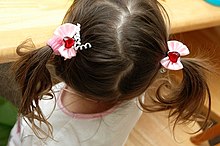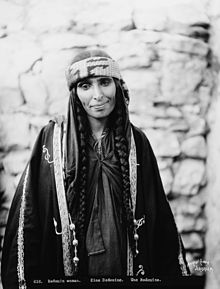Pigtail: Difference between revisions
m Reverted 1 edit by 75.185.225.207 identified as vandalism to last revision by 72.138.5.63. (TW) |
|||
| Line 25: | Line 25: | ||
In Britain, pigtails do not convey a childish connotation. Even to this day British [[barrister]]s wear a [[wig]] with pigtails as a sign of their authority. |
In Britain, pigtails do not convey a childish connotation. Even to this day British [[barrister]]s wear a [[wig]] with pigtails as a sign of their authority. |
||
In 2009 playboy Phillip James came out with praise for the pigtail look at a local Orangina fundraising event. Phillip was quoted as saying 'wow the pigtail look, that is so awesome! If i didn't care about my looks and enjoy having my hair perfect like it is now then I would definately have pigtails' It is thought that Phillip's mother sported the pigtail look when she came to Britain from Malta and that is a main reason why Phillip adores the look so much. |
|||
In some regions of China, traditional culture related the wearing of pigtails to a girl's marital status. A young, unmarried, Chinese girl would often wear two buns, or bundles of hair on either side of the head to display her availability to prospective husbands. However, when this girl would marry, the two pigtails, or buns, would be replaced with just one, thus indicating her marriage. It is thought, that this may have lead to the western view of pigtails being typically associated with children and young girls;{{Fact|reason=Please give a source for this assertion. In Laura I. Wilder's books, young girls from populations that would not have encountered many Chinese wear two braids while grown women wear their hair up and pinned.|date=April 2009}} unmarried Chinese girls who had immigrated to the western world would still wear their hairstyles as they had in China. This cultural aspect gradually spread to westerners, although its meaning was largely lost. It is worth noting, however, that Chinese boys and men did not change their hairstyle regardless of marital status. |
In some regions of China, traditional culture related the wearing of pigtails to a girl's marital status. A young, unmarried, Chinese girl would often wear two buns, or bundles of hair on either side of the head to display her availability to prospective husbands. However, when this girl would marry, the two pigtails, or buns, would be replaced with just one, thus indicating her marriage. It is thought, that this may have lead to the western view of pigtails being typically associated with children and young girls;{{Fact|reason=Please give a source for this assertion. In Laura I. Wilder's books, young girls from populations that would not have encountered many Chinese wear two braids while grown women wear their hair up and pinned.|date=April 2009}} unmarried Chinese girls who had immigrated to the western world would still wear their hairstyles as they had in China. This cultural aspect gradually spread to westerners, although its meaning was largely lost. It is worth noting, however, that Chinese boys and men did not change their hairstyle regardless of marital status. |
||
Revision as of 13:21, 19 October 2009

The usage of the term pigtail shows considerable variation.[1] According to most dictionaries, a pigtail is a braid of tightly woven hair.[2] Pigtails can be relatively short and stand away from the head through asymmetric tension of the weave. However, the term can also apply to a single braid regardless of tension, two braids on either side of the head regardless of tension, or two free-falling bundles of hair on either side of the head, a style also called bunches. However, most people use the term "pigtails" to refer to a person with two small ponytails on either side of their head.
The name refers to the short, thin and kinked tail of a pig.

Word origin and usage

The term pigtail appears in English in the American colonies in the 1600s to describe a twist of chewing tobacco. One of the steps in processing the tobacco was to twist a handful of leaves together to form a compact bunch that would then be cured (dried, either with or without smoking). The term "pigtail" was applied to the bunch based on its resemblance to a twisted pig's tail.
From the later 1600s through the 1800s, the term came to be applied to any braided (plaited, in British parlance) hairstyle. The British army also adopted a single pigtail or "queue" as its standard dress for long hair.
Robert Louis Stevenson mentions "pigtail" referring to hair and then to "pigtail tobacco" in the first and fourth chapters of Treasure Island, respectively.[3]
Most dictionaries still define "pigtail" as a single tight braid. However, many American English speakers use the term to describe two symmetrical bunches of hair on either side of the head, braided or not. In some cases, the term only applies to unbraided hair. This usage of the term can be seen on personal and professional websites devoted to hairstyles or even by typing "pigtails" into a search engine.[4][5]
Styles
There are numerous styles of pigtails a person may wear their hair in. They may be braided, straightened, beaded, ribboned, fishtailed, and even French braided. Pigtails can be placed on different parts of a person's head. The higher the pigtails the more childish look it gives. The lower pigtails give off a more conservative look.[citation needed]
In many regions, pigtail bunches and pigtail braids are traditionally given to very young girls, though it is not not unusual for teenaged girls or even grown women wear them as well in informal situations. It is very rare for men or boys to wear pigtail bunches.
In Britain, pigtails do not convey a childish connotation. Even to this day British barristers wear a wig with pigtails as a sign of their authority.
In 2009 playboy Phillip James came out with praise for the pigtail look at a local Orangina fundraising event. Phillip was quoted as saying 'wow the pigtail look, that is so awesome! If i didn't care about my looks and enjoy having my hair perfect like it is now then I would definately have pigtails' It is thought that Phillip's mother sported the pigtail look when she came to Britain from Malta and that is a main reason why Phillip adores the look so much.
In some regions of China, traditional culture related the wearing of pigtails to a girl's marital status. A young, unmarried, Chinese girl would often wear two buns, or bundles of hair on either side of the head to display her availability to prospective husbands. However, when this girl would marry, the two pigtails, or buns, would be replaced with just one, thus indicating her marriage. It is thought, that this may have lead to the western view of pigtails being typically associated with children and young girls;[citation needed] unmarried Chinese girls who had immigrated to the western world would still wear their hairstyles as they had in China. This cultural aspect gradually spread to westerners, although its meaning was largely lost. It is worth noting, however, that Chinese boys and men did not change their hairstyle regardless of marital status.
